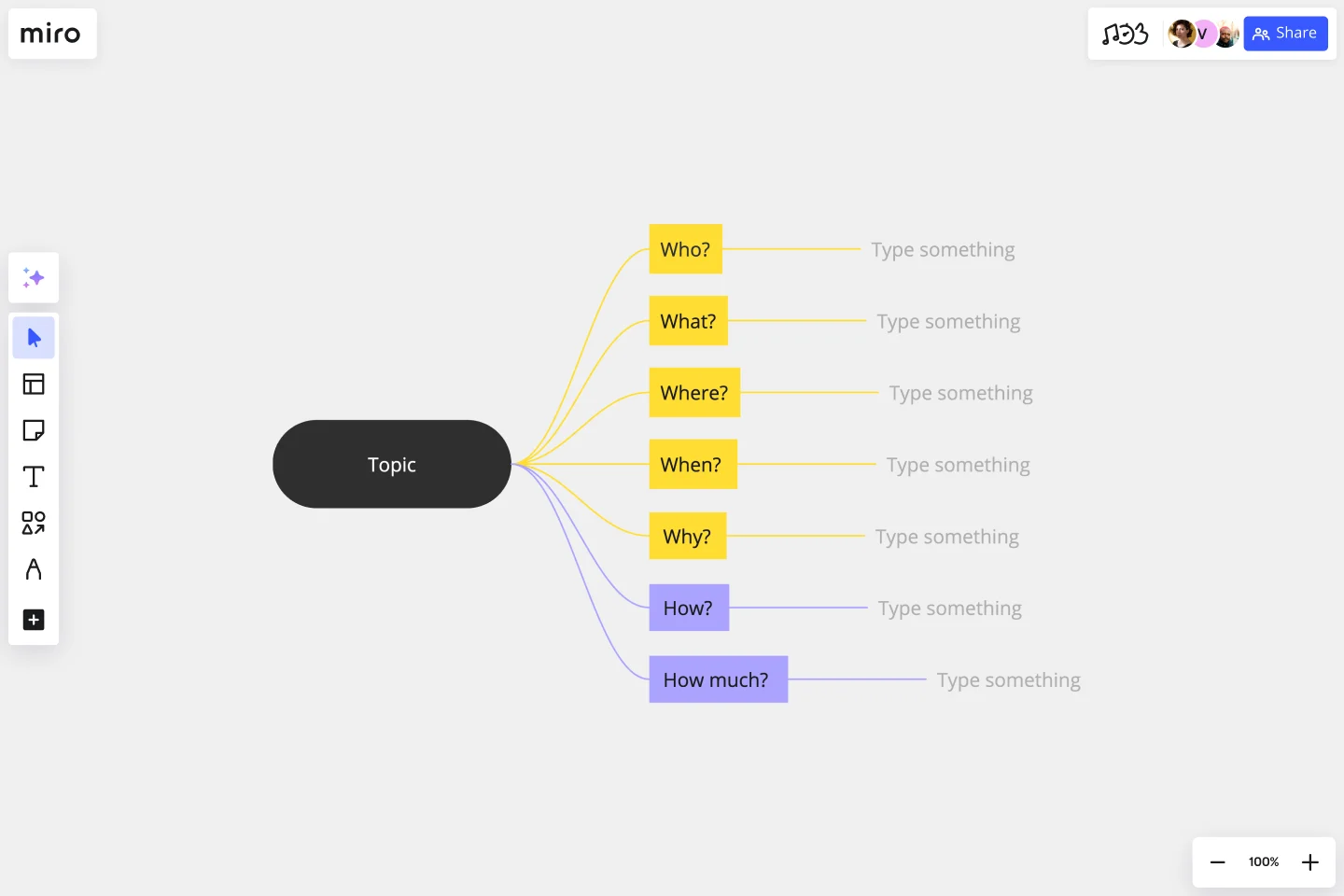5W2H Template
Explore a structured approach to project management addressing the who, what, when, where, why, how, and how much with the 5W2H template.
About the 5W2H Template
The 5W2H framework is a valuable tool that can help you streamline your thought process and improve your project management skills. This structured approach involves answering seven questions that can help you gather and organize information effectively.
The questions are: Who, What, When, Where, Why, How, and How Much. You can make informed decisions and achieve better outcomes by examining a situation comprehensively.
What: Identify the core task or issue.
Why: Understand the purpose or motive behind it.
Who: Pinpoint the people or teams involved.
When: Establish the timeline and deadlines.
Where: Specify the location or context.
How: Explore the methods or processes.
How Much: Determine the resources or quantities involved.
This template is a guiding framework, ensuring no crucial aspect is overlooked.
How to use the 5W2H Template in Miro
Edit easily: Customize the template effortlessly by filling in relevant details or changing the questions.
Expand with a click: Effortlessly expand the template to explore details with a single click, providing a deeper dive into each element.
Add contextual artifacts: Enhance your board by incorporating documents, images, or other artifacts that provide additional context to your 5W2H analysis.
Why should you use a 5W2H Template?
1. Clarity and focus: The template provides a structured approach, helping teams clarify objectives and focus on key aspects.
2. Efficient problem solving: the 5W2H template facilitates thorough problem analysis and effective solutions by addressing all relevant questions.
3. Improved communication: Enhance communication within teams by ensuring that everyone is on the same page regarding project details.
4. Time management: Clearly defined timelines and deadlines ensure better time management, reducing delays and improving project efficiency.
5. Comprehensive understanding: The template encourages a thorough understanding of a situation, minimizing the risk of overlooking critical details.
Is the 5W2H template suitable for all types of projects?
Yes, the template's versatility makes it applicable to various projects, from simple tasks to complex problem-solving scenarios.
How can I get all crucial information when using the template?
The structured nature of the 5W2H template guides you through each essential question, reducing the likelihood of overlooking key details.
Get started with this template right now.
Roadmap Planning Template
Works best for:
Roadmap, Agile
The Roadmap Planning Template in Miro is a dynamic tool designed to streamline the process of planning and tracking project milestones. This template is part of Miro's Intelligent Templates offering, which integrates AI, interactive widgets, and automation to enhance productivity. One key feature of this template is its real-time collaboration capability, allowing team members to work together seamlessly, regardless of their location. This feature ensures that everyone is on the same page, making it easier to assign tasks, set deadlines, and track progress effectively.
What's on Your Radar Template
Works best for:
Business Management, Operations, Strategic Planning
Do you or your team feel overburdened by tasks? Having trouble focusing on particular problems? What’s on Your Radar is a thought exercise in which you plot ideas according to their importance or relevance. Designers and teams use what’s on your radar to ensure that their ideas are within the scope of a given project. They also rely on the method to assess whether a given solution is likely to solve the problem at hand. But even if you’re not a designer, the method can help assign priorities and ground your ideas in reality.
Fishbone Diagram by Dave Westgarth
Works best for:
Fishbone diagram
Identify and solve problems effectively with the Fishbone Diagram by Dave Westgarth. This template helps you break down complex issues into root causes, enabling a thorough analysis and targeted solutions. Use it for quality control, process improvement, and troubleshooting in various industries. Ideal for teams focused on continuous improvement and problem-solving.
Sprint Planning Template
Works best for:
Agile, Sprint Planning
The Sprint Planning Template is a useful tool for agile teams to organize and conduct sprint planning sessions. It enhances team collaboration and communication by providing a clear visual layout of sprint goals, tasks, and timelines. The interactive design ensures team alignment toward sprint objectives, leading to effective teamwork. The template is a central hub for planning, discussion, and decision-making, creating a collaborative and productive environment.
PI Planning Template
Works best for:
Agile Methodology, Strategic Planning, Software Development
PI planning stands for “program increment planning.” Part of a Scaled Agile Framework (SAFe), PI Planning helps teams strategize toward a shared vision. In a typical PI planning session, teams get together to review a program backlog, align cross-functionally, and decide on the next steps. Many teams carry out a PI planning event every 8 to 12 weeks, but you can customize your planning schedule to fit your needs. Use PI planning to break down features, identify risks, find dependencies, and decide which stories you’re going to develop.
Daily Standup with Jira Template
Works best for:
Daily Standup
The template is designed to improve team collaboration and streamline daily stand-up meetings by integrating Jira with Miro. This template transforms stand-ups into visual, interactive sessions, enabling teams to see real-time status updates and automatically sync changes with Jira. The key benefit of this template is its seamless integration, ensuring that all relevant information is centralized in one place. This fosters a more engaging and inclusive environment for team members, while also saving time and reducing the risk of miscommunication.
